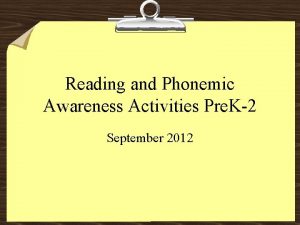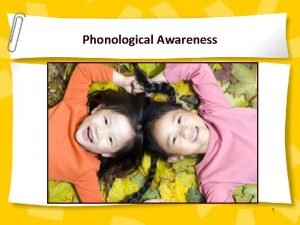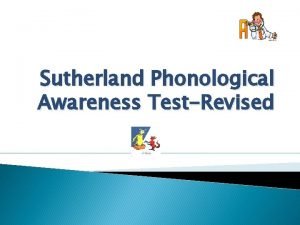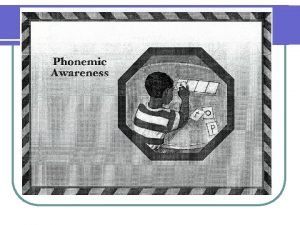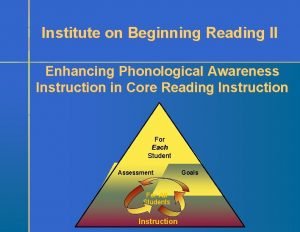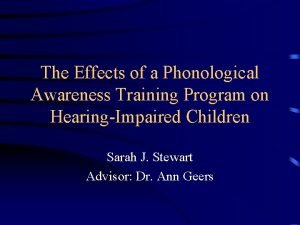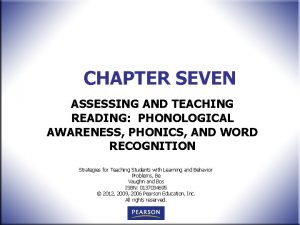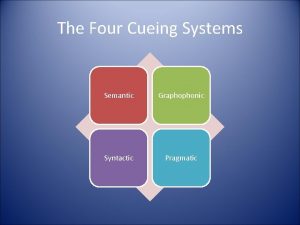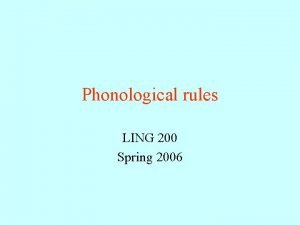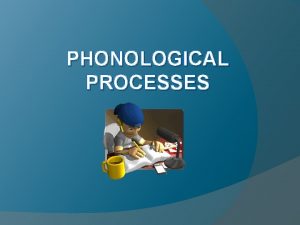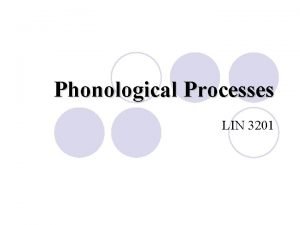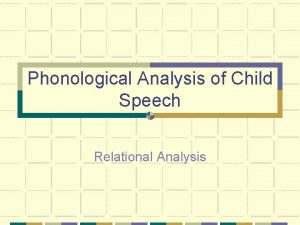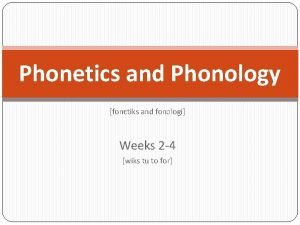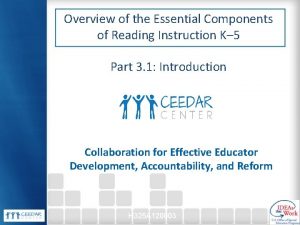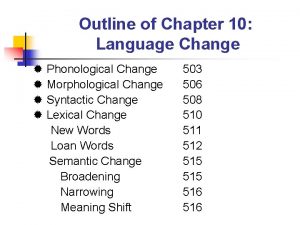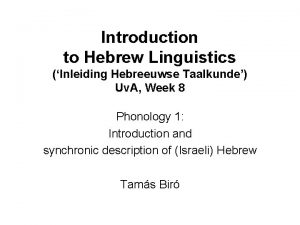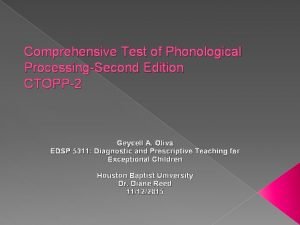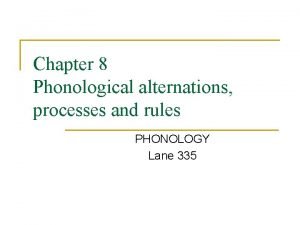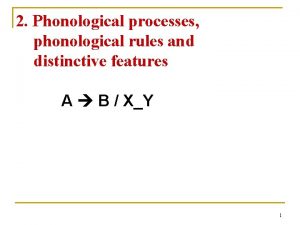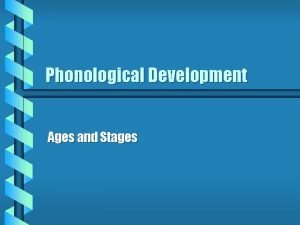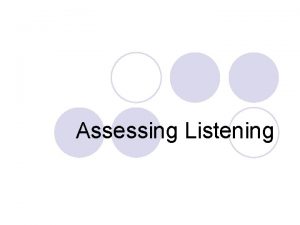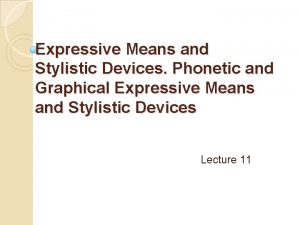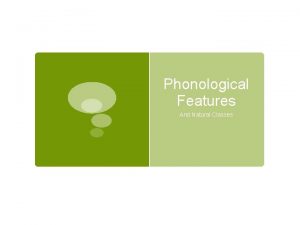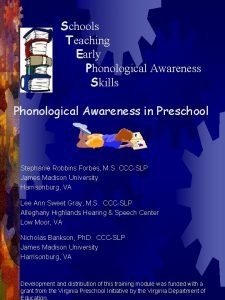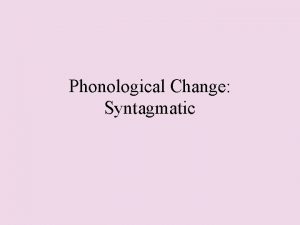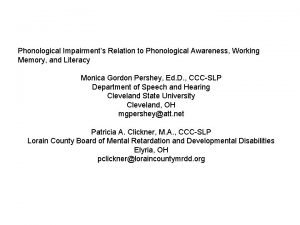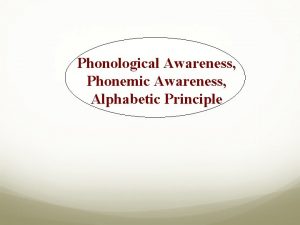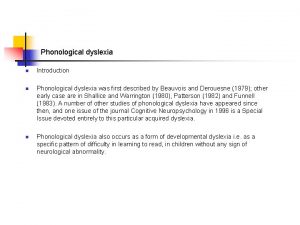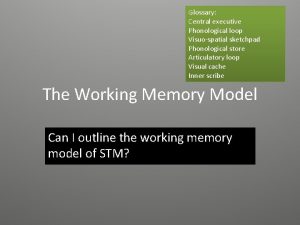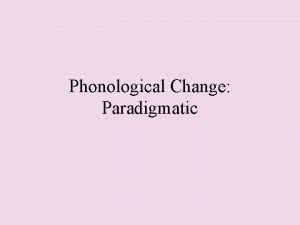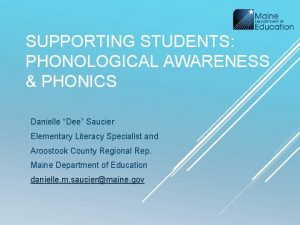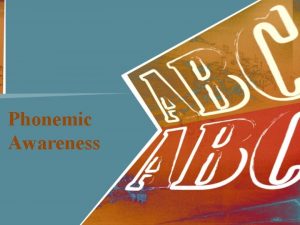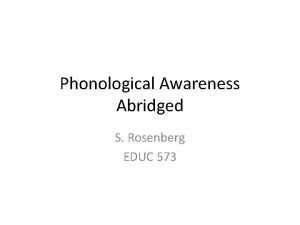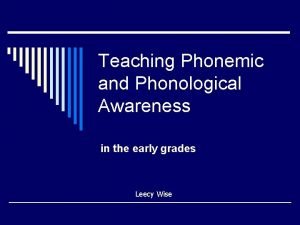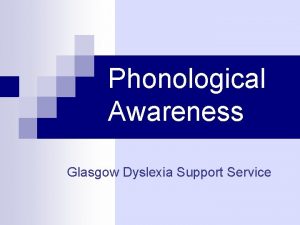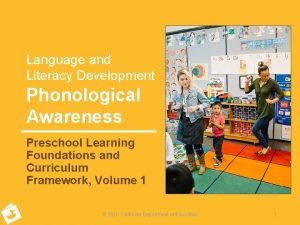Phonological Awareness 1 Do You Recognize These Students




































- Slides: 36

Phonological Awareness 1

Do You Recognize These Students? Late learning to talk, slow vocabulary growth Inconsistent memory for words, lists, and directions Struggle with rhyming and pronunciation of words and names Unable to associate letters with sounds Trouble segmenting and blending speech sounds Slow to learn the alphabet letter names or forms

Poor readers at the end of first grade… Are at significant risk for long term academic difficulty 88% probability of being a poor reader in fourth grade if a poor reader in the first grade. 87% probability of remaining an average reader in fourth grade, if an average reader in the first grade. (Juel, 1988) Are likely to require intensive instructional support Juel, C. Learning to Read and Write: A Longitudinal Study. Journal of Educational Psychology, 80, 4. 437 -447. 3

Phonology • Phonological working memory is critical to learning to read • Vowels differ according to size and shape of the oral cavity • Vowels that are close together on the vowel chart are most easily confused • There is a systematic instructional progression in phonological awareness • Phoneme awareness should be a consistent component of daily lessons in K-1; activities should be brief and distributed • Development of skills should be monitored with DIBELS, analysis of writing and teacher observation 4

Phonology - The LETRS Connection • Speaking is natural; Learning to read is not • Oral language is the foundational skill for reading and writing • In English we spell by sound and by meaning: Wanted, hummed, pitched • • English is a ‘Deep’ Alphabetic System Reading develops along a developmental continuum Teach foundational skills to mastery Consonant phonemes differ by placement, manner of production, and voicing 5

Early Intervention makes the difference It is considerably more efficient and effective to deliver intervention earlier rather than later in elementary school. is less efficient, and • Later intervention often less effective. • It takes four times as long to remediate a child’s poor reading skills in fourth grade as in kindergarten or early first grade. (Lyon & Fletcher, 2001) page 7

Phonemic Awareness and Phonological Awareness-is there a difference? Phonological Awareness Phonemic Awareness 7

…can be viewed on a continuum. 8

Grades 1 -3 9

Working Memory and Automaticity Processi ng Task Less Fluent Reader Working Memory Processi ng Task More Fluent Reader Colorado Reading Fi

The Processing Systems involved in Reading Fluency Fl ue Adams, Marilyn J. (1990) Beginning To Read cy Speech Phonics en Phonologi cal Processor Meaning Process or u Fl nc y Context Process or Orthograp hic Processor Print

Research Findings to Guide Instruction • Instruction must be more focused, explicit & systematic • Include word identification strategies and reading fluency practice with connected text • Provide ample opportunities for guided practice, appropriate levels of scaffolding and responsive feedback • Teach with small teacher/student ratios • Teach intensively Double. Foorman dose, if(University possible of Texas) and Joe Torgesen (University of Barbara 12

Summarize Why is Phonological awareness instruction critical in grades K-1? 13

Phonological Awareness Continuum Let’s take a closer look… 14

Phonemic Awareness Ø the ability to notice, think about and work with the individual sounds in spoken words Ø is auditory - does not involve print (can be done “in the dark”) Ø is essential to learning to read an alphabetic writing system Ø critical component of instruction in kindergarten

Strategies for teaching Phonemic Awareness Teach the sound and feel of the phonemes. Lips Teeth/ Lips Tongue/ Teeth Ridge/ Teeth Roof of Mouth Back of Throat Stops /p/ /b/ /t/ /d/ /k/ /g/ Nasals /m/ /ng/ Fricatives /f/ /v/ /th/ /s/ /z/ /sh/ /zh/ /ch/ /j/ Affricates Glides Liquids Glottis /y/ /l/ /r/ /wh/ /w/ /h/

Strategies for teaching Phonemic Awareness Teach the sound and feel of the phonemes. ē see these me eat key happy chief either ə about lesson elect definition circus ĭ sit gym ā make rain play great baby eight vein they oi/oy oil, boy ou/ow out, cow ĕ bed breath oo � ō ă cat aw ī time pie cry right rifle ŭ ŏ fox swap palm cup cover flood though saw pause call water bought vote boat toe snow open go took put could ū yū moo tube blue chew suit soup cute few universe feud er her, fur, sir ar cart or sport

Let’s Test Your Phonemic Awareness How many speech sounds are in these words? boil 3: /b/ /oi/ /l/ king 3: /k/ /i/ /ng/ ox 3: /o/ /k/ /s/ thank 4: /th/ /a/ /ng/ /k/ straight 5: /s/ /t/ /r/ /aigh/ /t/ though 2: /th/ /ough/ shout 3: /sh/ /ou/ /t/ precious 6: /p/ /r/ /e/ /sh/ /ə/ /s/

Assessing Phonemic Awareness DIBELS – First Sound Fluency (measures ability to segment and produce initial sounds in words) – Phoneme Segmentation Fluency (measures ability to segment words into phonemes) Informal Measures – – – Phoneme segmentation (student segments) Phoneme blending (student blends) Rhyming (student recognizes or produces rhyme) Isolating by position (initial, final, medial) Manipulating phonemes (insert, delete, substitute)

The Pairs Unvoiced Sound (“Quiet”) Voiced Sound (“Noisy”) Label /p/ /t/ /k/ /b/ /d/ /g/ Lip Poppers Tip Tappers Tongue Scrapers /f/ /th/ /sh/ /ch/ /v/ /th/ /zh/ /j/ Lip Coolers Tongue Coolers Skinny Air Fat-Pushed Air

Other Consonant Groups - The Cousins Consonant Group Label /m, n, ng/ Nose Sounds /w, h, wh/ Wind Sounds /l, r/ Lifters

Borrowers ‘C’ Sounds like /k/ or /s/ ‘X’ Sounds like /ks/ ‘Qu’ Sounds like /kw/ ‘Y’ Usually borrows vowel sounds at end of word like the name of the letter i or the name of e In middle of word ‘y’ says /i/ gym or /ie/ cyclone Front of word ‘y’ says ‘yuh’ yes /ee/

Let’s practice… Groups of 4 – Start at a station. Review the directions. Using the materials – each member practices the strategy with the group to rehearse the routine. Rotate 23

Activity: Arm-Counting for Syllables Segment and Blend 24

Activity: Finger Tapping for Sounds Segment and Blend 25

Sound Toss Koosh Ball Games Silent Ball Sentence Segmentation Same Sound Start Rhyming Initial – Final Game Multi-syllabic Word Games 26 Adapted from Games and Activities for Readers and Spellers by Coultas & Whitney

Sound Boxes Make Sounds Real… p. 12 27 Have students use a marker to mark the sounds they are hearing.

Tap it, Map it and Zap it! - p. 12 /f/ • • /l/ /a/ /g/ Teacher says the word. Students repeat the word. Students “tap” the sounds in the word. Students “map” the sounds in the word with sound markers. Students “zap”, blend, the sounds together! 28

Listen and Clap p. 18 This activity develops and reinforces students’ ability to listen to and think about sounds in words. It provides opportunities to compare and make judgments about the sounds they hear. This is a dog. Say it? dog Dog begins with the sound /d/ Yes or No? Students ‘clap their hands’ if dog begins with /d/ 29

Flyswatter Sounds 30

Use of a Whisper Phone • Arouses or stimulates the phonological processor • Use when listening and learning new sounds or words • Monitor use of this tool

Sentence Segmenting

Grab Bag Surprise • Gather small objects and put them in a surprise grab bag. • Reach into the bag and choose an object, but keep it hidden. • Segment the name of the object into syllables or sounds. • Have children blend the word for the object. Then have them segment the word. BELLS, pages 199 -200

Teaching Phonemic Awareness in Young Children Groups of 4 – One Chapter per Group Review Chapter and prepare to Share: – Continuum? – Sample Activity? 34

Lesson Planning Look at days 1 -5 Code the Lesson Plan for Daily Phonology Practice Review/Plan the Activities Work Smarter, not harder Share Work!! 35

Time to Work!!! 36
 Why is phonological awareness important
Why is phonological awareness important Phonological awareness continuum chart
Phonological awareness continuum chart Sutherland phonological awareness test
Sutherland phonological awareness test Crac marzollo
Crac marzollo Phonological awareness skills from easiest to hardest
Phonological awareness skills from easiest to hardest Phonological awareness training program
Phonological awareness training program Phonological awareness ppt
Phonological awareness ppt Phonological awareness
Phonological awareness Cvs privacy awareness and hipaa training answers
Cvs privacy awareness and hipaa training answers Vicenta ybardolaza description
Vicenta ybardolaza description What is ambiguty
What is ambiguty Syntactic cue
Syntactic cue Phonological loop
Phonological loop Psy
Psy Phonological rule examples
Phonological rule examples What are minimal pairs in linguistics
What are minimal pairs in linguistics Phonological rule examples
Phonological rule examples Morphonemics
Morphonemics Vowel phonological processes
Vowel phonological processes Independent analysis speech
Independent analysis speech Allophone
Allophone Phonological continuum
Phonological continuum Semantic change
Semantic change Proto semitic
Proto semitic Ctopp-2 composite score descriptions
Ctopp-2 composite score descriptions Phonological development in child language acquisition
Phonological development in child language acquisition Alpha notation phonology
Alpha notation phonology Phonological rule
Phonological rule Phonological fossilization
Phonological fossilization Phonological analysis example
Phonological analysis example Phonological development stages
Phonological development stages The importance of listening in lang..
The importance of listening in lang.. Lexical ambiguity jokes
Lexical ambiguity jokes Expressive means
Expressive means Phonological features chart
Phonological features chart How does katniss react to peeta’s declaration of love?
How does katniss react to peeta’s declaration of love? Organization of ideas in reading
Organization of ideas in reading
